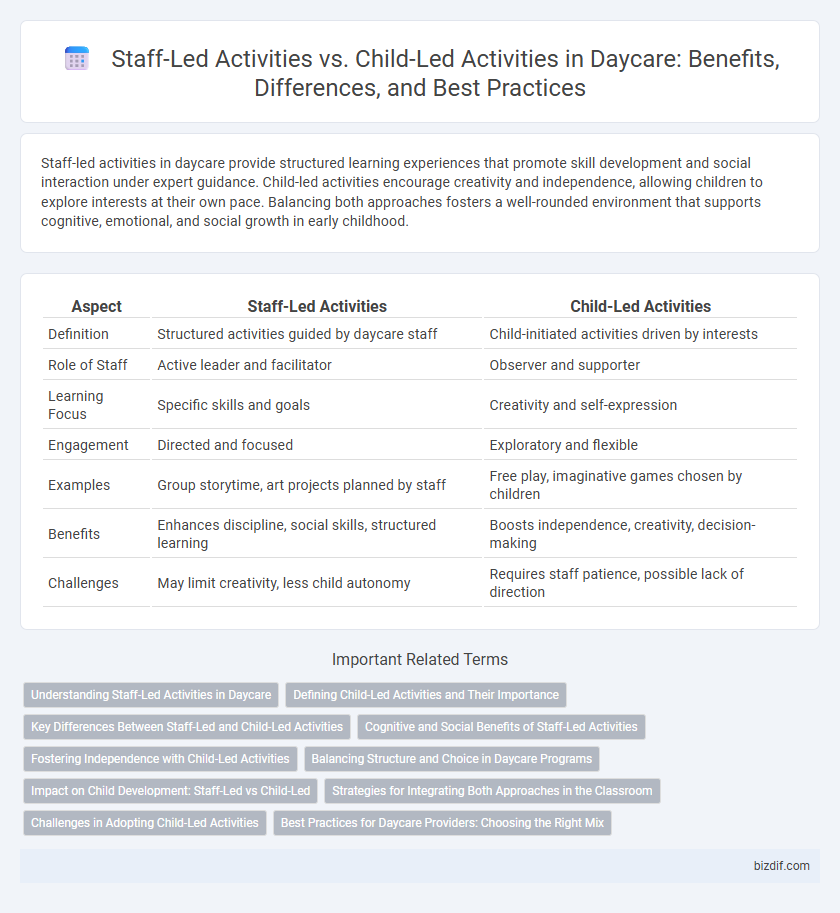Staff-led activities in daycare provide structured learning experiences that promote skill development and social interaction under expert guidance. Child-led activities encourage creativity and independence, allowing children to explore interests at their own pace. Balancing both approaches fosters a well-rounded environment that supports cognitive, emotional, and social growth in early childhood.
Table of Comparison
| Aspect | Staff-Led Activities | Child-Led Activities |
|---|---|---|
| Definition | Structured activities guided by daycare staff | Child-initiated activities driven by interests |
| Role of Staff | Active leader and facilitator | Observer and supporter |
| Learning Focus | Specific skills and goals | Creativity and self-expression |
| Engagement | Directed and focused | Exploratory and flexible |
| Examples | Group storytime, art projects planned by staff | Free play, imaginative games chosen by children |
| Benefits | Enhances discipline, social skills, structured learning | Boosts independence, creativity, decision-making |
| Challenges | May limit creativity, less child autonomy | Requires staff patience, possible lack of direction |
Understanding Staff-Led Activities in Daycare
Staff-led activities in daycare involve structured programs designed and guided by caregivers to promote specific developmental skills such as literacy, motor skills, and social interaction. These activities provide a framework for children to engage in learning through themed lessons, organized play, and instructional tasks that align with early childhood education standards. Understanding staff-led activities is essential for ensuring a balanced curriculum that supports cognitive growth while maintaining an organized environment conducive to learning and safety.
Defining Child-Led Activities and Their Importance
Child-led activities in daycare emphasize children's autonomy, allowing them to choose their own play and learning experiences based on interests and curiosity. These activities foster creativity, decision-making skills, and self-confidence by encouraging exploration and independent problem-solving. Research shows that child-led approaches significantly enhance cognitive development and social-emotional skills, promoting holistic growth in early childhood education.
Key Differences Between Staff-Led and Child-Led Activities
Staff-led activities in daycare settings are structured and guided by caregivers to promote specific learning outcomes and maintain routine, while child-led activities prioritize children's interests and encourage autonomy and creativity. Staff-led sessions often follow a defined curriculum and schedule, fostering skill development in areas such as literacy and socialization, whereas child-led play supports exploration and decision-making, adapting dynamically to children's evolving preferences. The balance between these approaches impacts developmental goals, with staff-led activities providing foundational skills and child-led experiences nurturing independence and self-expression.
Cognitive and Social Benefits of Staff-Led Activities
Staff-led activities in daycare settings significantly enhance cognitive development by providing structured learning opportunities that promote problem-solving, memory retention, and language skills. These guided interactions also foster social benefits, such as teaching cooperation, turn-taking, and effective communication, which are essential for building healthy peer relationships. Research shows that consistent engagement in staff-led activities correlates with improved emotional regulation and increased confidence in social settings.
Fostering Independence with Child-Led Activities
Child-led activities in daycare settings foster independence by encouraging children to make choices and explore their interests freely, promoting critical thinking and problem-solving skills. These activities support autonomy and self-confidence, allowing children to take initiative and learn at their own pace. Staff facilitate rather than control, creating an environment that nurtures creativity and individual growth.
Balancing Structure and Choice in Daycare Programs
Effective daycare programs balance staff-led activities that provide structure and skill development with child-led activities that encourage creativity and autonomy. Structured group activities like storytime and guided play promote social skills and routine, while child-led choices foster independence and personalized learning experiences. Striking the right balance supports holistic development by combining consistent adult guidance with opportunities for children to explore their interests freely.
Impact on Child Development: Staff-Led vs Child-Led
Staff-led activities in daycare provide structured learning environments that promote cognitive skills, socialization, and discipline through guided interaction and expert facilitation. Child-led activities foster creativity, independence, and problem-solving abilities by allowing children to explore interests and make choices, thereby enhancing self-confidence and intrinsic motivation. A balanced approach combining both methods optimizes developmental outcomes, supporting emotional, social, and intellectual growth in early childhood.
Strategies for Integrating Both Approaches in the Classroom
Balancing staff-led activities with child-led activities in daycare fosters holistic development and engagement by combining structured learning with autonomy. Implementing a flexible schedule allows caregivers to initiate educational themes while providing space for children to explore interests independently, enhancing creativity and decision-making skills. Utilizing observation and feedback, staff can tailor interventions that support individual learning styles, promoting a dynamic and responsive classroom environment.
Challenges in Adopting Child-Led Activities
Child-led activities in daycare often face challenges such as staff needing to balance guidance with allowing autonomy, which requires specialized training and a flexible curriculum. Limited resources and time constraints hinder the ability to fully support spontaneous child interests while maintaining safety and educational goals. Resistance from parents accustomed to structured, staff-led approaches can also impact the successful implementation of child-led learning environments.
Best Practices for Daycare Providers: Choosing the Right Mix
Balancing staff-led activities with child-led play is essential for fostering development in daycare settings, where structured guidance promotes cognitive skills while autonomous exploration nurtures creativity. Effective daycare providers implement a flexible schedule that allocates time blocks for both teacher-directed lessons and free play, allowing children to develop social, emotional, and problem-solving abilities. Incorporating evidence-based practices such as observation and responsive adjustments ensures that the chosen mix aligns with individual child needs and supports optimal growth outcomes.
Staff-Led Activities vs Child-Led Activities Infographic

 bizdif.com
bizdif.com